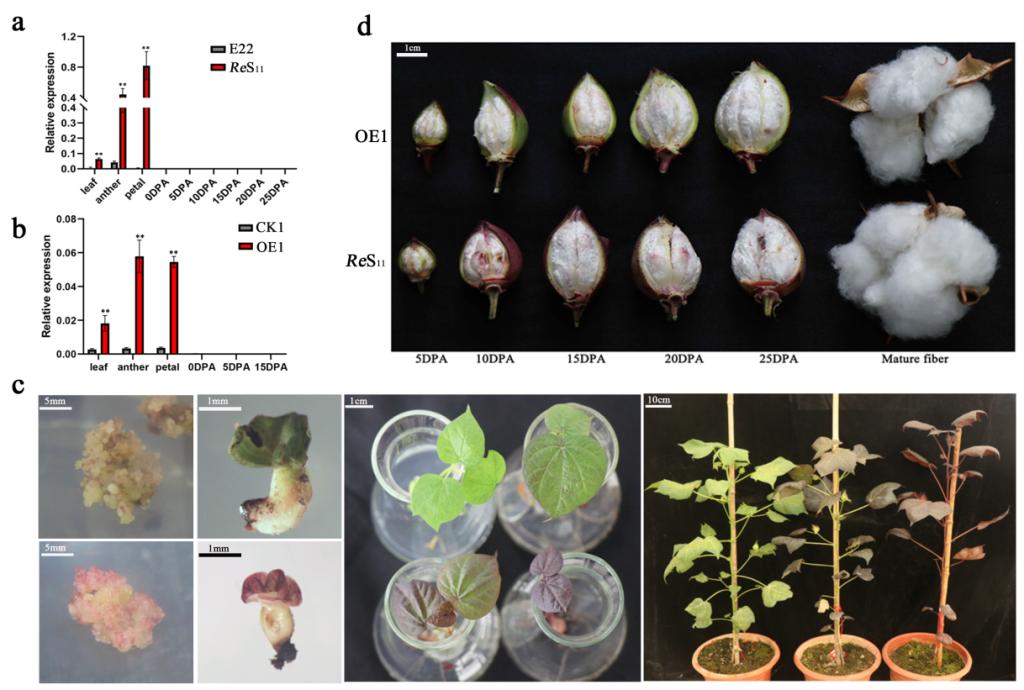3月15日,国际知名植物学杂志Plant Physiology刊发了我校棉花遗传改良团队题为“Re enhances anthocyanin and proanthocyanidin accumulation to produce red foliated cotton and brown fiber”的研究论文,该研究解析了一个海岛棉和陆地棉种间杂交获得的红色植株突变体的遗传机制,并利用纤维特异启动子将该基因在纤维中特异表达,获得了棕色纤维的棉花。该研究赋能一个普通基因,使其发挥“特殊”功能,开辟了一个创造彩色棉花的新途径。
棉花是最主要的天然纤维原料,彩色棉是纤维与色素的结合体。天然彩棉可以减少印染过程中的能源消耗与环境污染,在碳中和的大背景下,与绿色节能的生产、消费理念更加契合,也是拓展棉花产业价值的重要方向。目前天然彩棉以棕色和绿色为主,拓展新的彩色棉种质资源是培育彩色棉新品种亟待解决的问题。
在实验室前期的研究中,在海岛棉3-79与陆地棉E22的杂交后代中发现了一个红株突变体,突变体全株呈现紫红色,但成熟纤维依旧保持正常白色。经过9代的连续自交,得到纯合突变体(ReS9)。利用ReS9与E22构建了含1899株F2隐性单株的群体,通过图位克隆,将候选基因锁定在D07号染色体上。通过代谢路径分析,表达量检测与TA克隆,最终确定候选基因为MYB113类的转录因子,命名为Re。利用35S启动子驱动Re转化Jin668,在组织培养的各个时期均观察到明显的花青素积累,得到叶片不同程度红色的转化系,但是最终成熟的纤维依旧为白色。

图1. 35S启动子超表达Re在组织培养各个时期观察到花青素积累
套袋实验证明突变体中Re的表达受自然光的诱导。利用突变体、35S启动子超表达系以及纤维特异表达系在自然光和温室两种条件下的转录组数据,研究团队构建了陆地棉中参与色素代谢的核心基因集,并初步构建了Re参与的色素代谢网路。PIF4可能是Re响应自然光的因子,Re可以直接调节类黄酮代谢路径下游ANS和UFGT的表达,从而影响PA与花青素的积累。

图2. Re调控棉花产生红色植株的遗传机制
通过纤维特异表达启动子GbEXPA2的驱动,研究团队成功地得到在开花后5-10 天的纤维中高量特异表达Re的转化材料,并获得植株正常绿色而发育中的纤维呈紫红色的转化系。但随着纤维的发育,紫红色逐渐变浅,最终的成熟纤维呈现出不同程度深浅的棕色。通过检测纤维中原花色素(PA)与花青素的含量,PA的大量积累是成熟纤维呈棕色的主要原因。

图3. GbEXP2驱动Re在5-10 DPA纤维中高量特异表达
该实验结果为彩棉的研究提供了新的思路,为创制更多颜色的棉花纤维奠定了基础,如何保持花青素在纤维中稳定的积累,以及协调PA等其它代谢物的积累,可能是创制彩色纤维棉花的突破口。
太阳集团tcy8722作物遗传改良国家重点实验室林忠旭教授为论文的通讯作者,博士生汪念为第一作者,团队带头人张献龙教授参与了该研究。本研究受到国家转基因生物育种重大专项(No. 2016ZX08009001)的资助。感谢本团队的涂礼莉教授提供纤维特异启动子,感谢太阳集团tcy8722作物遗传改良国家重点实验室生物信息计算平台的支持和帮助。
【英文摘要】
Red foliated cotton is a typical dominant mutation trait in upland cotton (Gossypium hirsutum). Although mutants have been described, few responsible genes have been identified and characterized. In this study, we performed map-based cloning of the red foliated mutant gene (Re) derived from the cross between Gossypium hirsutum cv. Emian22 and G. barbadense acc. 3-79. Through expression profiling, metabolic pathway analysis and sequencing of candidate genes, Re was identified as a MYB113 transcription factor. A repeat sequence variation in the promoter region increased the activity of the promoter, which enhanced the expression of Re. Re expression driven by the 35S promoter produced a red foliated phenotype, as expected. When the gene was driven by a fiber elongation–specific promoter, promoter of α-expansin 2 (PGbEXPA2), Re was specifically expressed in 5–10 days post-anthesis (DPA) fibers rather than in other tissues, resulting in brown mature fibers. Re responded to light through phytochrome-interacting factor 4 (PIF4) and formed a dimer with transparent testa 8 (TT8), which increased its expression as well as that of anthocyanin synthase (ANS) and UDP-glucose:flavonoid 3-o-glucosyl transferase (UFGT), and thus activated the entire anthocyanin metabolism pathway. Our research has identified the red foliated mutant gene in cotton, which paves the way for detailed studies of anthocyanin and proanthocyanidin metabolism and pigment accumulation in cotton and provides an alternative strategy for producing brown fiber.
论文链接:
https://academic.oup.com/plphys/advance-article/doi/10.1093/plphys/kiac118/6548804?searchresult=1


